The North Torrey Pines Living and Learning Neighborhood
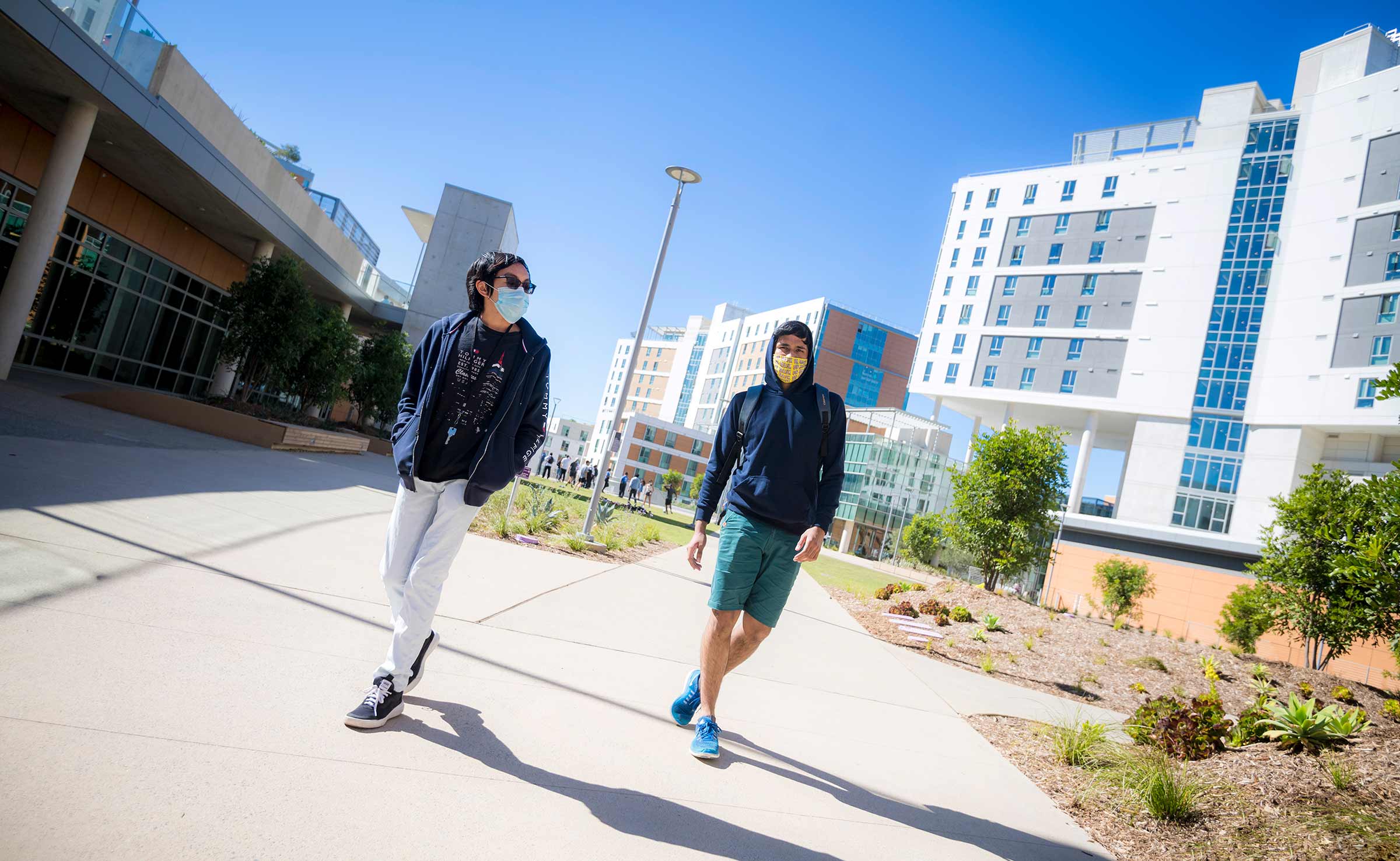 The Neighborhood Springs to Life
The Neighborhood Springs to Life
After welcoming students to the west side residential areas in the fall, the east side of North Torrey Pines Living and Learning Neighborhood is starting to spring to life.
This quarter, the UC San Diego Craft Center welcomed the campus community to meet its new instructors, a three-story HDH dining area with five restaurants and a market brought flavors from across the globe, Sixth College administration and two academic schools settled into their new spaces and the Stuart Collection’s “Same Old Paradise” was installed in its home in the heart of the neighborhood—all of which contributed to making the vision of the university’s first living and learning neighborhood a reality.
“With each new milestone, our vision of serving students and making our campus a preferred destination for the greater community is strengthened,” said Chancellor Pradeep K. Khosla. “UC San Diego is where students come to explore, discover and grow; where scholars and researchers collaborate to solve society’s most challenging problems; and where our community comes to recharge, expand their knowledge, and experience art, culture and recreation.”
Connection and creativity at the Craft Center
A team of artist instructors have joined UC San Diego Craft Center Manager Annika Nelson to support hands-on art classes in the five core Craft Center programs of ceramics, jewelry-making, woodworking, surfboard shaping and culinary arts. The Craft Center recently invited the campus community to meet some of the new instructors and participate in hands-on workshops during a virtual event.
“It was an exciting challenge to think about how to bring a studio experience to a virtual environment,” said Craft Center artist-instructor Susan Wickstrand. “Through this reimagining, I discovered that creativity is not limited, the art is not compromised and we were able to connect with people we may not have reached otherwise.”
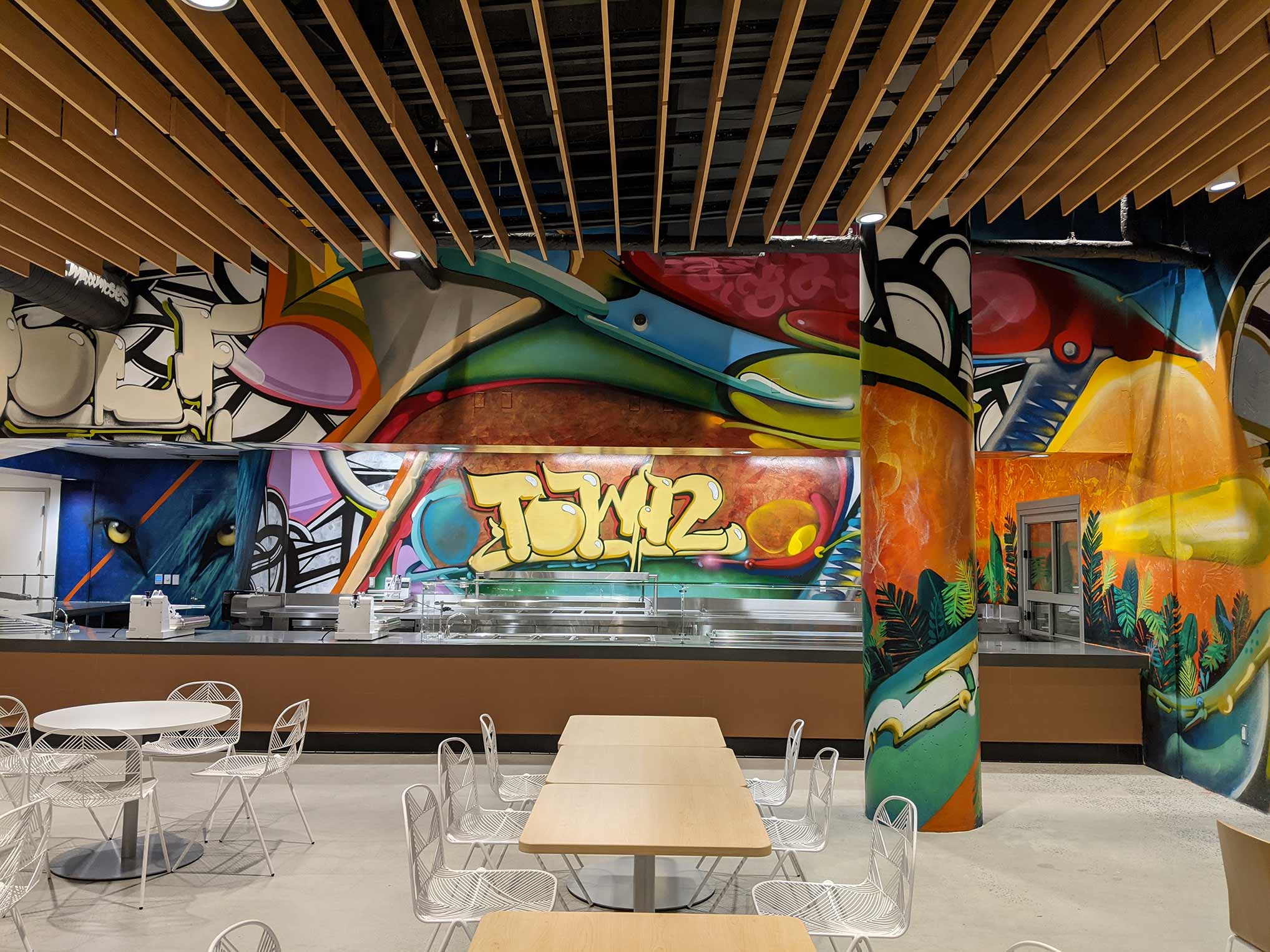 Delicious and healthy dining, 2Go
Delicious and healthy dining, 2Go
A three-story, light-filled, nearly 20,000-square-foot building with the largest market on campus, Sixth Market, is now open, bringing five new exceptional campus dining options.
- Makai, which means “toward the sea,” features fresh fish and poke bowls
- Noodles focuses on Asian noodle-, grain- and dumpling-based soups
- Crave offers plant-forward entrees with an option to add meat or other proteins from the grill
- Wolftown pairs global street food with a classic taqueria
- The Rooftop features an outdoor mesquite grill and smokehouse
One college administration and two academic schools
Sixth College administration and the Schools of Social Sciences and Arts and Humanities have moved into three new academic buildings that support instruction, engagement and collaboration.
Sixth College has helped to make the neighborhood a live-learn lab. From its inception, the project team explored issues around student health and well-being, interviewing Sixth College students about which elements of their environment contributed positively and negatively to their college life.
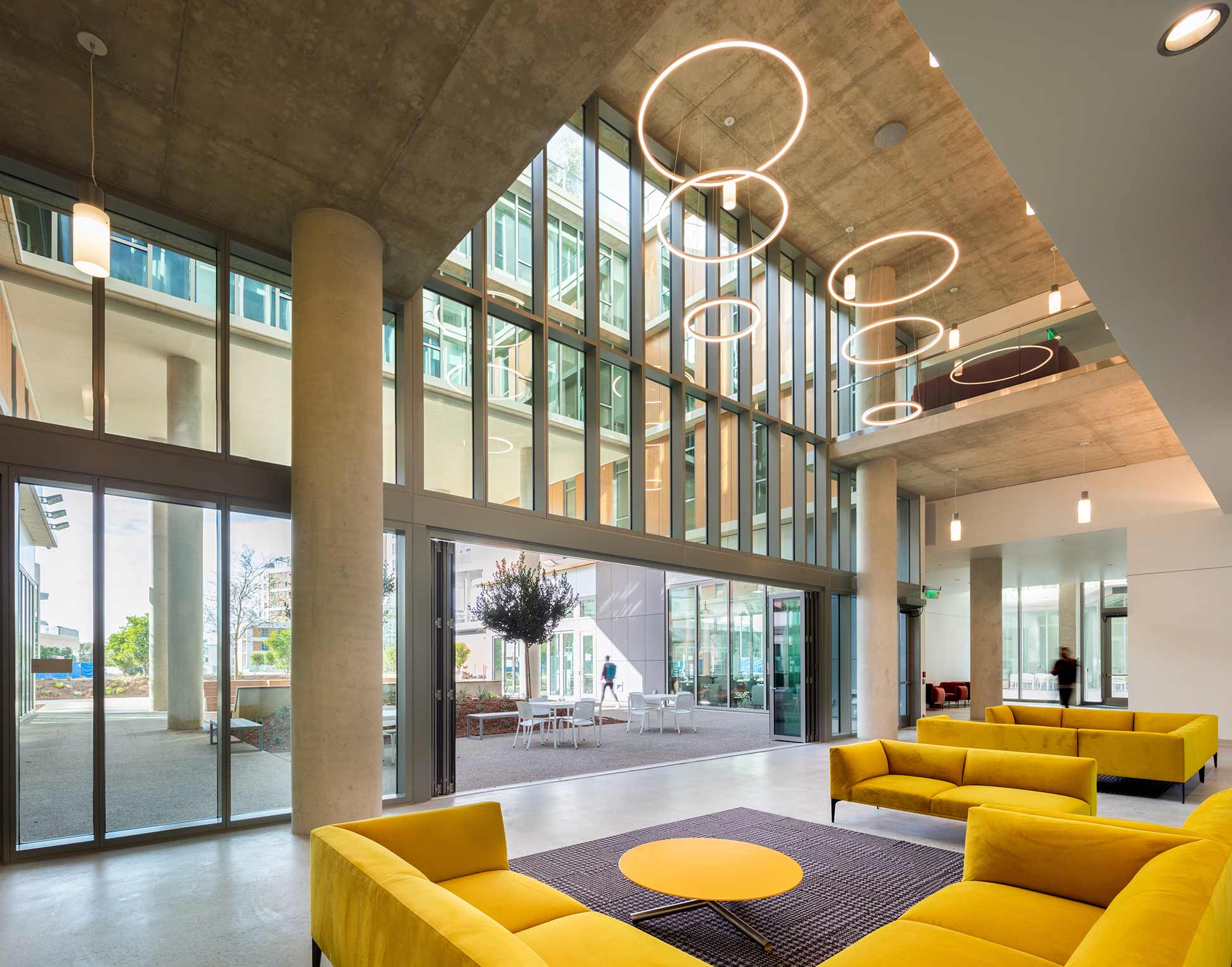 The Arts and Humanities Building brings together for the first time the Office of the Dean, the departments of Philosophy, History and Literature, the Institute of Arts and Humanities and the Analytical Writing Program. In 2017, the School of Arts and Humanities received a first-of-its-kind Capacity Building and Challenge Grant from the National Endowment for the Humanities to directly support construction of the new location for the Institute of Arts and Humanities.
The Arts and Humanities Building brings together for the first time the Office of the Dean, the departments of Philosophy, History and Literature, the Institute of Arts and Humanities and the Analytical Writing Program. In 2017, the School of Arts and Humanities received a first-of-its-kind Capacity Building and Challenge Grant from the National Endowment for the Humanities to directly support construction of the new location for the Institute of Arts and Humanities.
At the time of the announcement, Arts and Humanities Dean Cristina Della Coletta called the support a “catalyst” and said, “a top, public university serves its students best by giving them a well-rounded…education that includes arts and humanities.” As the school completes its move into the neighborhood, the matching portion of the grant has been met.
Social Sciences’ Public Engagement Building features open spaces — “spaces intentionally designed for flow and interaction, for hands-on learning and collaboration,” said Dean Carol Padden — where social scientists will continue to do the science of society, working on pressing social issues in partnership with community organizations and members of the broader public.
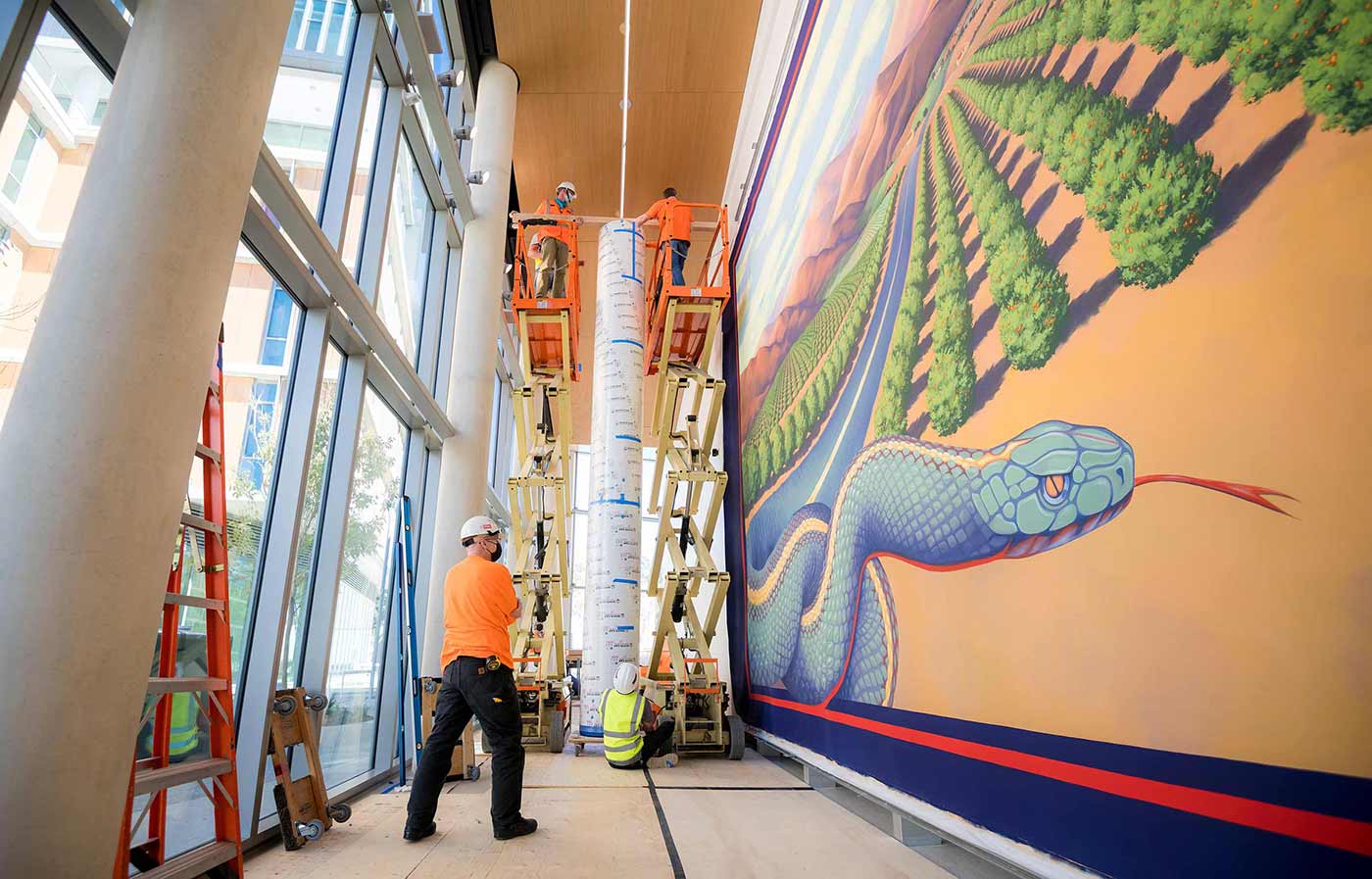 A unique home for monumental art
A unique home for monumental art
A 22- by 62-foot mural, “Same Old Paradise,” by Alexis Smith, references the search for paradise. It depicts a road transforming into an immense snake within a landscape of California hills and orange groves. The work also features eight framed collages reflecting the thoughts of Sal Paradise, the main character in Jack Kerouac’s autobiographical novel, “On the Road.” The mural, which is the first painting to be included in the Stuart Collection, was the inspiration for the iconic “Snake Path,” which was installed in 1992.
Read the full story in the UC San Diego News Center >>.
Latest news from the neighborhood
Updated Jan. 20, 2021
A neighborhood like no other.
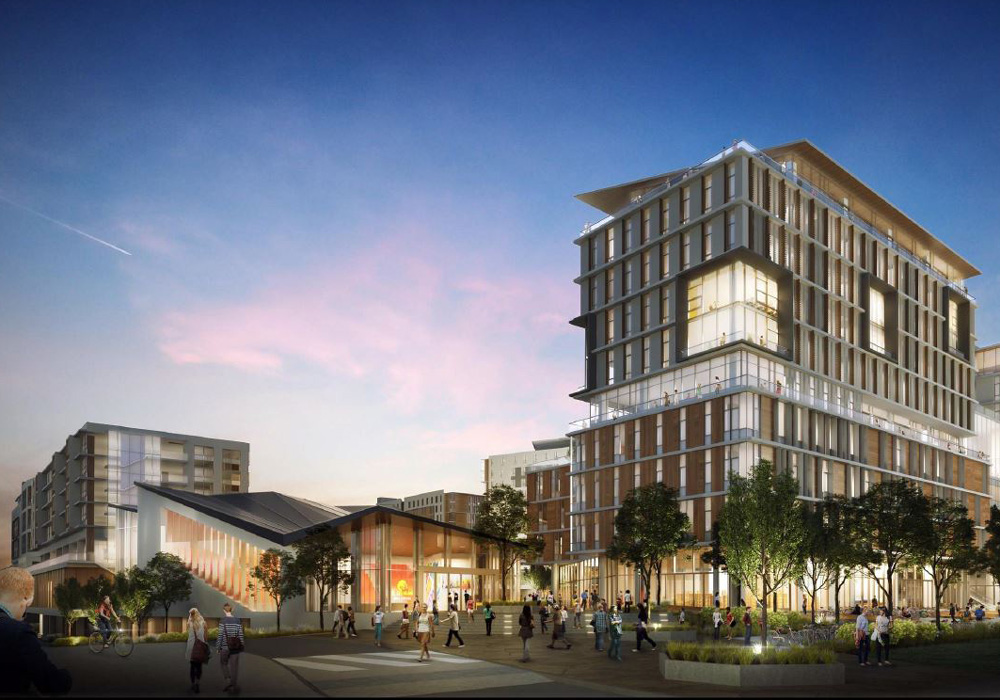 The North Torrey Pines Living and Learning Neighborhood is an innovative, mixed-use community that will further connect students with each other, faculty and staff by incorporating residential, academic and administrative space.
The North Torrey Pines Living and Learning Neighborhood is an innovative, mixed-use community that will further connect students with each other, faculty and staff by incorporating residential, academic and administrative space.
To open during the 2020 - 2021 academic year, the living and learning neighborhood will become the home of the School of Arts and Humanities, the Instititue of Arts and Humanities, the Analytical Writing Program and all three of our humanities departments: History, Literature and Philosophy.
What is the status of the NEH matching grant?
In 2018, the National Endowment for the Humanities awarded the School of Arts and Humanities an Infrastructure and Capacity Building Challenge grant designed to leverage federal funding in order to create, strengthen and sustain humanities infrastructure.
The three-year matching grant directly funded construction of the new location for the Institute of Arts and Humanities in the North Torrey Pines Living and Learning Neighborhood. The institute oversees 15 interdisciplinary academic programs in regional, ethnic and thematic studies, with the most recent addition being the new Asian American and Pacific Islander Studies program.
As the school plans their final move into the new building, the matching portion of the grant has been met, signifying a deep commitment to the institute and initiatives in the School of Arts and Humanities.
“We knew receiving the National Endowment for the Humanities grant would be a catalyst for validating the importance of the humanities to our students and faculty. We are nonetheless overwhelmed by the support from the community, whose trust in our mission is represented in their matching gifts,” Dean Cristina Della Coletta said. “I am grateful for their commitment that continues beyond the NEH grant, and grateful for the faculty and staff who worked tirelessly to meet this challenge. Thank you.”
- Daniel and Phyllis Epstein
- George and Penelope Nicholas
- Gerry and Jeannie Ranglas
- Ann and Joel Reed
- Carol Vassiliadis
- Christopher and Patricia Weil
- Bebe and Marvin Zigman
What is the updated move-in schedule?
UPDATE Jan. 20, 2021: The below outline was updated to accomodate changes in the move-in schedule.
##
Due to safety protocols for employees and construction/building staff, a limited number of personnel will be allowed to access the building at this time.
This updated schedule is based on multiple factors, and is susceptible to change. Contact your area head directly to confirm.
- Jan. 11-13:
- Dean's Office (10th floor)
- Analytical Writing Program (5th floor)
- Institute of Arts and Humanities (6th floor)
- Completing move Jan. 20-22:
- Philosophy (4th floor)
- Jan. 25-29:
- Literature (2nd and 1st floors)
- Starting move Feb. 1:
- History (7th through 9th floors)
When should I access the new building?
We anticipate having all of the moves completed on a pending schedule during winter quarter. This is all dependent upon whether units are prepared to move, if Moving Services can complete the work in the time allowed, and all safety protocols are being met in regards to COVID-19 and the campus Return to Learn guidelines.
In order to maintain safe occupancy limits, access to the new building will be limited to those who will be participating directly with the physical move. For those not involved with the physical move, please refrain from unnecessarily entering the building.
How will I receive my UC San Diego One Card to access the building?
As outlined below, access to the new building will be granted to registered occupants via the use of a UC San Diego One Card on the exterior-door card readers. If you have not been able to upgrade to a One Card, a new card will be issued and sent to your area manager (MSO or CAO).
Employees may pick up their new One Cards when they meet with their area manager to obtain new keys to the building.
Watch the latest video
We're getting close, is there a construction update?
“We were recently given a special tour of the new Arts and Humanities Building, giving access to each of the 10 floors. Construction continues, including A/V installation on each of the floors and landscaping has begun for the complex. Sixth College has nearly finished their move into the neighborhood, and students have begun to arrive in preparation for the start of Fall Quarter, at a reduced footprint. We anticipate receiving the keys to the building in December, and are currently completing a move-in schedule that will accommodate all our departments in a safe and efficient manner.” – Tad Linfesty, Divisional Facilities Manager (September 2020)
What new restaurants will be coming to the the neighborhood?
Six exciting restaurants are coming to the new North Torrey Pines Living and Learning Neighborhood in 2021, bringing the best of the local restaurant scene to campus. Students shared in surveys that they are looking for food that represents the “San Diego experience” on campus.
Blue Bowl
Blue Bowl is the original create-your-own superfood bowl concept that serves a wide range of superfood bases and unlimited topping combinations for a flat bowl price. Blue Bowl began in farmers’ markets and grew to have multiple locations in Los Angeles and Orange Counties. Two of the partners forged lifelong friendships as roommates while undergraduates at UC San Diego.
Copa Vida
Copa Vida Café is a Specialty Coffee, Tea and Food company that was born in Pasadena and grew in San Diego. With seven café locations and one roasting company that has been in operations for seven years, Copa Vida specializes in designing experiences for customers with a focus on creating community gathering places where the coffee, tea and food becomes a basis for dialogue, connections and great times.
Fan-Fan
Fan-Fan features delicious and healthy Chinese and Asian fusion food at reasonable prices. Fan-Fan and Taste of Hunan in Scripps Ranch are focused on flavors from Hunan, famous for aromatic and spicy flavor. Fan-Fan, led by a UC San Diego Rady School MBA alumn, opes to transform the culinary experience on campus by offering the best in Asian cuisine with a warm and friendly environment for anyone to call their home away from home.
Plant Power
Plant Power Fast Food specializes in 100% plant-based versions of all of the fast-food classics, such as hamburgers, fries and shakes served in compostable and biodegradable packaging. Their mission is to provide healthier, new choices that are better for the planet and our animal friends.
Shōwa Ramen
Shōwa Hospitality presents UC San Diego’s new ramen spot, Shōwa Ramen, inspired by the retro era in Japan. The chef will create both Japanese style ramen such as tantan noodle and spicy miso as well as Chinese style ramen. For health enthusiasts, vegetable ramen and seasonal ramen will be offered.
Tahini
Tahini is the story of two best friends' quest to bring you the most authentic Middle Eastern street food. Tahini is operated by a group of immigrants and refugees, bakers and butchers, and students and artists, with different backgrounds and religions, who came together over a shared love of freshly prepared pita bread, house made falafel, shawarma and more.
Are there any pictures to share from the student move in?
UC San Diego has commenced with plans to welcome back students, faculty and staff to campus for the Fall Quarter through an incremental repopulation of campus, which started in August and increased in mid-September with undergraduate student move-in. Pictures here are from Sixth College move-in, into the North Torrey Pines Living and Learning Neighborhood.
Undergraduates will move in, in a reduced capacity, over a 10-day period at assigned days and times in order to allow for expedited testing and minimized contact with others. The university has comprehensive plans to reduce, mitigate and care for those impacted by COVID-19 and are able to take actions on campus that can make coming to work, living or taking classes here relatively safe, among all the activities campus community members might do in their daily life.
Learn more about the UC San Diego Return to Learn >>
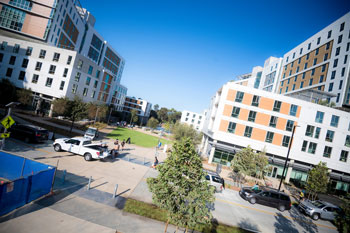
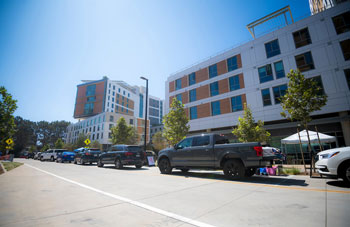
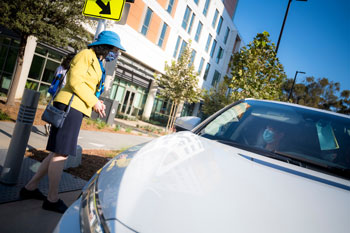
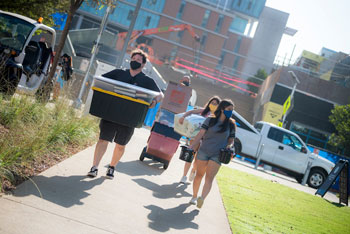


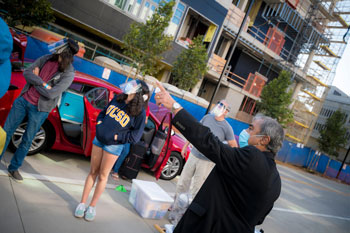


Is there an arial photo of the new neighborhood?
Check out the artist rendering (top) with this drone photo taken June 29, 2020
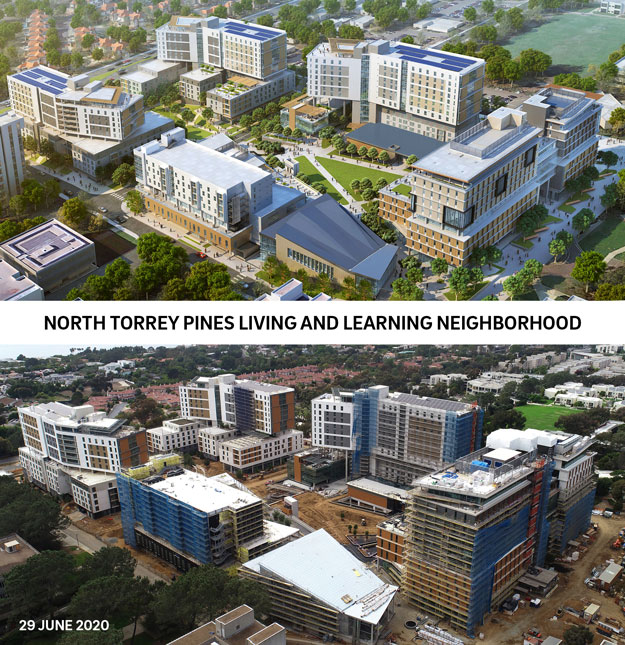
What is the general moving plan for the Arts and Humanities Building?
The move for the departments, institute, program and Dean's Office to be housed in the Arts and Humanities building will be a collaborative effort, coordinated with all tenants in the new neighborhood. The schedule continues to evolve, and tenants will be informed of a detailed timeline in order to prepare accordingly. For immediate questions, contact Tad Linfesty, Arts and Humanities facilities manager.
What information is there about the Craft Center?
 Visual artist and designer Annika Nelson has been chosen by Housing, Dining and Hospitality to lead the new 11,000-square-foot UC San Diego Craft Center, marking a key milestone in the long-awaited return of a beloved creative community hub.
Visual artist and designer Annika Nelson has been chosen by Housing, Dining and Hospitality to lead the new 11,000-square-foot UC San Diego Craft Center, marking a key milestone in the long-awaited return of a beloved creative community hub.
The Craft Center will be an important part of the North Torrey Pines Living and Learning Neighborhood, which was designed to bring together academic, cultural, residential and retail spaces to inspire exploration, collaboration and connection. Similarly, the center will offer students, faculty, staff and the local community unique opportunities to connect and create.
“I believe in the power of art-making to break down barriers and provide opportunities for dialogue that do not happen in other spaces,” said Nelson. “The Craft Center provides a unique opportunity for people from all corners of San Diego to meet.”
Nelson’s career has been dedicated to forging connection and inspiring creativity. She earned a bachelor’s degree in studio art from UC Santa Cruz and went on to study printmaking at the University of Applied Arts in Vienna, Austria.
Do you have pictures of office furniture?
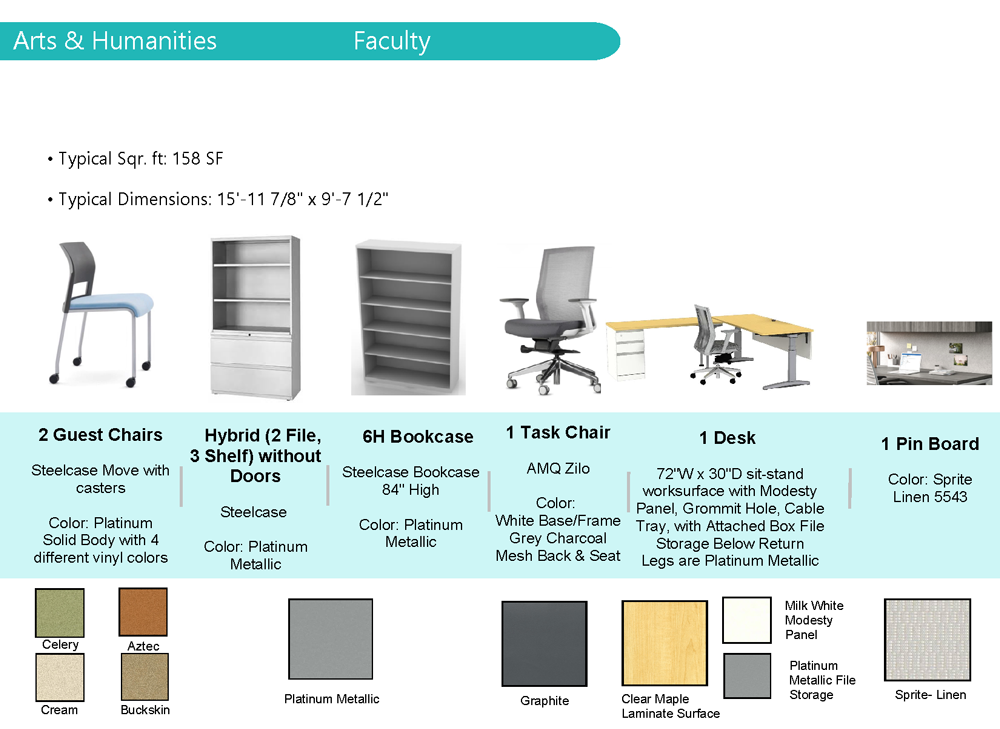
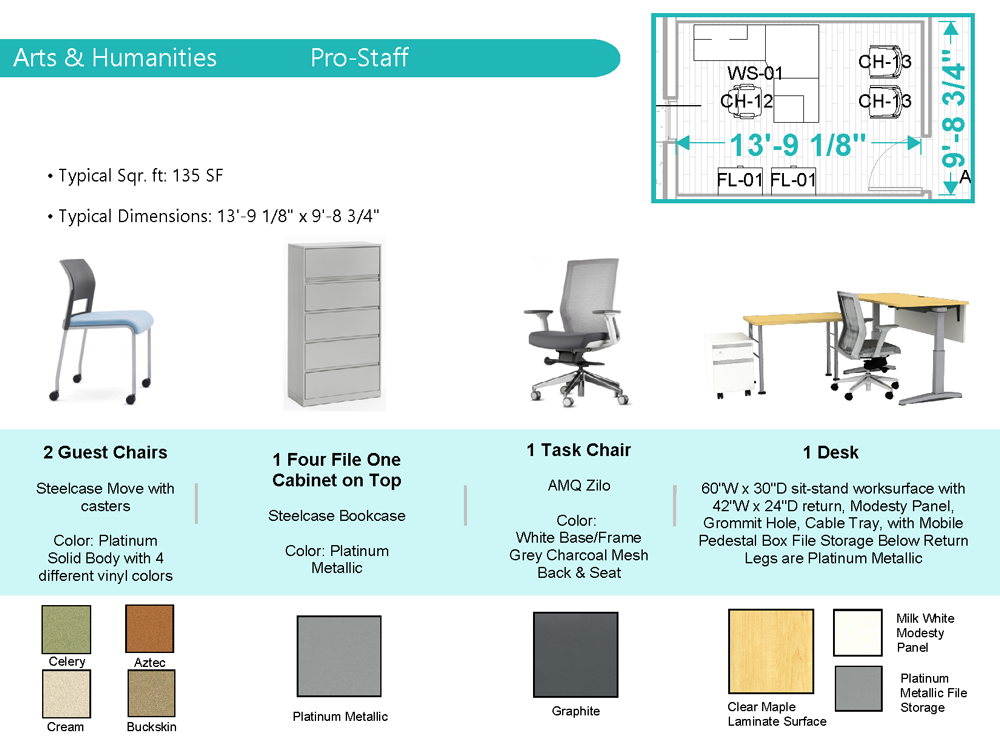
Note: images represent a general sample, and there will be slight differences based on specific department/area.
What is the status of additional campus transformation projects?
The response to the coronavirus pandemic will continue to have serious effects across the world, in the State of California and on campus. This includes a significant financial impact for University of California and UC San Diego for an unknown period of time.
One step the university will take to respond effectively to changes in the economic situation is to temporarily pause some planned campus transformation projects, including the Triton Pavilion and Hillcrest Outpatient Pavilion. The goal is to be able to quickly restart these projects when circumstances have improved and the campus is in a stronger position to move forward.
While some projects are on pause, many projects will proceed, largely because they are already under construction and funded, provide essential student housing and academic space or support health and safety on campus:
- North Torrey Pines Living and Learning Neighborhood
- Theatre District Living and Learning Neighborhood *renamed to this July 2020
- Pepper Canyon West Undergraduate Housing
- Design and Innovation Building
- UC San Diego Downtown Center
- Marine Conservation and Technology Facility
- Franklin Antonio Hall
- UC San Diego Blue Line Trolley extension
Read the full feature in ThisWeek @ UC San Diego.
What type of technology will be available on each floor of the Arts and Humanities building?
In addition to one or more conference and instruction rooms on each floor that will come equipped with state-of-the-art TV monitors and projection equipment for departmental business and instructional purposes, an interactive digital map will be located in the lobby and digital signage announcing events will be located throughout the building.
Can you say more about how the conference and instruction rooms are equipped?
Users will control the Atlona AV system using a touch panel display mounted on the wall or table, and connect their laptops to either of the HDMI or VGA connections that will seamlessly send their content to the projector and displays.
Some of rooms in the building will be outfitted with cameras and flush, ceiling-mounted microphones for networking with streaming and recording devices.
How will the buildings be secured?
Security cameras will be located throughout the complex and inside each of the buildings located in the North Torrey Pines Living and Learning Neighborhood. To gain access beyond the public areas, the buildings will be equipped with ID card readers that are compatible with the new UC San Diego One Card.
What steps should I take now to ensure I have access when needed?
The One Card project is a campus-wide initiative intended to enhance security, increase reader compatibility and improve operations across campus while eliminating the need to carry multiple ID cards.
All faculty and staff in the School of Arts and Humanities who do not already have the new UC San Diego One Card are encouraged to upgrade their Legacy ID card before relocating to the new building, as a One Card will be required to gain access beyond the public areas of the Arts and Humanities building.
Learn about the eligibility requirements and instructions to upgrade to the UC San Diego One Card. Access the One Card request form (PDF).
Alert
To ensure the safety and security of our entire community regarding COVID-19 and following guidelines from the Center for Disease Control and Governor of California, do not come to campus until official instruction to do so from the university. Keep up to date on the university’s COVID-19 response.How have construction and workers been impacted in regards to COVID-19?
In recognition of Governor Gavin Newsom’s Executive Order on March 19, construction projects at UC San Diego are proceeding. The university is working collaboratively with our contractors to assure that proper procedures are being implemented on all jobsites to comply with social distancing requirements and general safety recommendations from the CDC to slow the spread of COVID-19 throughout our community.
What is the impetus behind the Living and Learning Neighborhood?
Development of the Living and Learning Neighborhood presents an opportunity to help meet our on-campus housing goals while providing much-needed academic and support space — including a building specifically for the School of Arts and Humanities — that better connects departments and programs. Envisioned to be a vibrant and active hub, the neighborhood will also be a welcoming and comfortable place that promotes community.
What campus units will be in the North Torrey Pines Living and Learning Neighborhood?
The complete North Torrey Pines Living and Learning Neighborhood includes:

The Arts and Humanities Building (PDF) will be a physical hub where ideas and ideals will thrive — expanding, testing, and transforming the existing conventions of intellectual exchange among and across disciplines.

The Craft Center (PDF) classrooms, dedicated studios, and specialized facilities will provide ample opportunities to activate connections, conversations, and community.

The Social Sciences Public Engagement Building (PDF) will be a place for faculty, students, and the broader community to work together to generate ideas about quality of education and quality of life.

Sixth College’s four residential buildings will house 2,000 students, creating shared experiences, encouraging personal connection, and inviting participation and discovery.
What is the map of the Living and Learning Neighborhood?
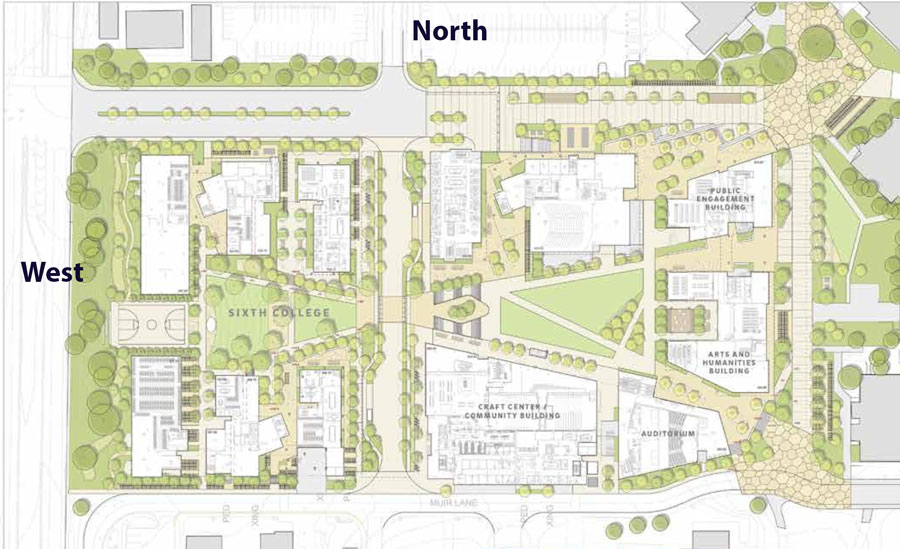
What units will be in the Arts and Humanities Building?
The Arts and Humanities building will include:
- School of Arts and Humanities Office of the Dean
- Department of History
- Institute of Arts and Humanities
- Analytical Writing Program
- Department of Philosophy
- Department of Literature
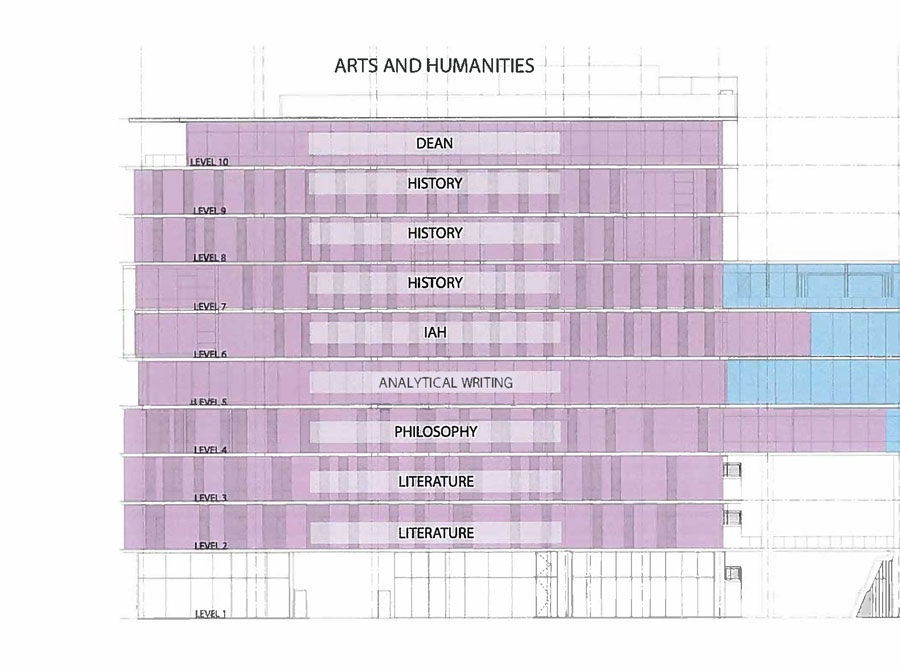
Can you explain the NEH infrastructure grant?
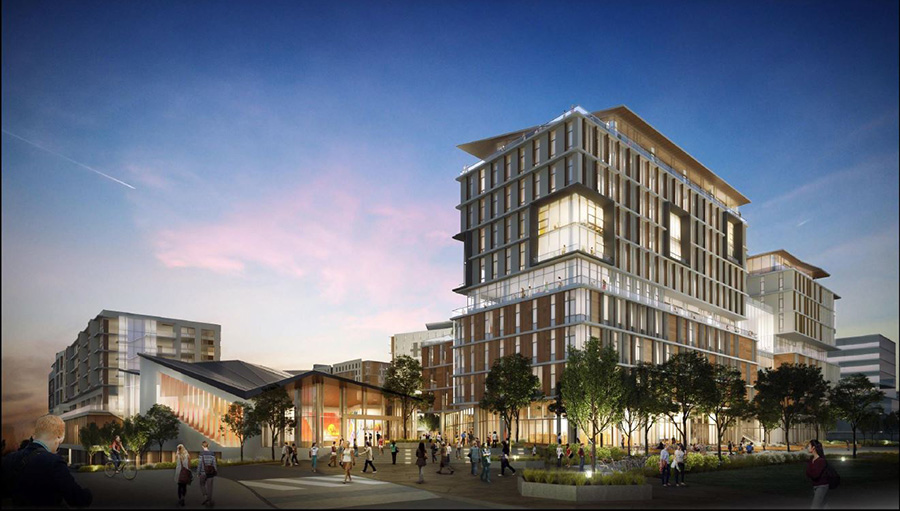 The arts and humanities will have a stronger and more influential presence on the University of California San Diego campus, thanks to a new $750,000 grant from the National Endowment for the Humanities. The three-year matching grant is the largest single award ever received by the university’s School of Arts and Humanities from the NEH.
The arts and humanities will have a stronger and more influential presence on the University of California San Diego campus, thanks to a new $750,000 grant from the National Endowment for the Humanities. The three-year matching grant is the largest single award ever received by the university’s School of Arts and Humanities from the NEH.First of its kind, the award is one of 29 nation-wide grants given by the NEH as part of their new Infrastructure and Capacity Building Challenge Grants program, designed to leverage federal funding in order to create, strengthen and sustain humanities infrastructure. These grants require a match of non-federal funds, and may be used toward construction and renovation projects. UC San Diego received the maximum amount eligible.
The NEH infrastructure grant directly funds construction of a new location for the school's Institute of Arts and Humanities, which includes the entire sixth floor of the Arts and Humanities Building in the forthcoming North Torrey Pines Living and Learning Neighborhood. This location will, in part, serve as a center of interdisciplinary collaboration.
Launched in 2017, the Institute of Arts and Humanities connects 15 interdisciplinary programs and centers that previously functioned in separate units on campus. Activities supported by the institute are focused on research and teaching, community involvement and public engagement. Initiatives center on global, public and digital humanities, and the institute has been led by Department of History professor Luis Alvarez since its inception.
With a footprint covering more than 10 acres, the 1.6 million-square-foot Living and Learning Neighborhood is the largest architectural undertaking in the campus’s history. The complex — expected to be ready for initial move-in Fall of 2020 — will become the new home for Sixth College, a craft center and retail offerings, as well as two new academic buildings: one for the School of Social Sciences and one for the School of Arts and Humanities.
The Arts and Humanities Building will also, for the first time in the university’s history, bring the three humanities departments of History, Literature and Philosophy, and the Analytical Writing Program together in one location, centralizing core humanistic study for maximum student impact.
The National Endowment for the Humanities (NEH) is an independent federal agency created in 1965. It is one of the largest funders of humanities programs in the United States. The endowment awards grants to top-rated proposals examined by panels of independent, external reviewers.
Note: Any views, findings, conclusions or recommendations expressed in this release do not necessarily represent those of the National Endowment for the Humanities.
What is the original construction schedule?
Construction is well underway with new student housing expected to be move-in ready by Fall 2020. Key dates include:
- Building structures: June through December 2019
- Building envelop and finishes: March through July 2020
- Landscaping: July through August 2020
Normal construction hours are 7 a.m. to 7 p.m. weekdays.
Is there a move-in timeline?
Occupants of the Arts and Humanities Building will have access to begin the move starting late August 2020, with full occupancy complete by the end of September. A detailed schedule for each department and unit will be developed.
Update: as of May 2020, tenants of the Arts and Humanities building will have access to begin moving in December 2020.
Update: Please read the most-recent Q&A regarding the December move timeline above.
How about parking and transportation?
The neighborhood will include an underground parking structure providing approximately 1,200 parking spaces – more than 200 more parking spaces than the former lots provided.
Visit the Transportation Services website for parking alternatives and shuttle service updates.
What sustainability concerns are being addressed?
UC San Diego is committed to meeting UC system-wide goals of achieving Leadership in Energy and Environmental Design (LEED) Silver Certification for all new buildings with North Torrey Pines Living and Learning Neighborhood seeking to achieve a LEED Platinum rating. Innovative design elements, like an anaerobic digester, condensate capture systems and onsite photovoltaics, will help to achieve this goal. Learn more about UC San Diego's Green Building Program.
School of Arts and Humanities Receives $750,000 NEH Infrastructure Award
National Endowment for the Humanities matching grant is largest federal award to date for division, supporting growth of arts and humanities on campus
Learn more about the entire project at the North Torrey Pines Living and Learning website.
